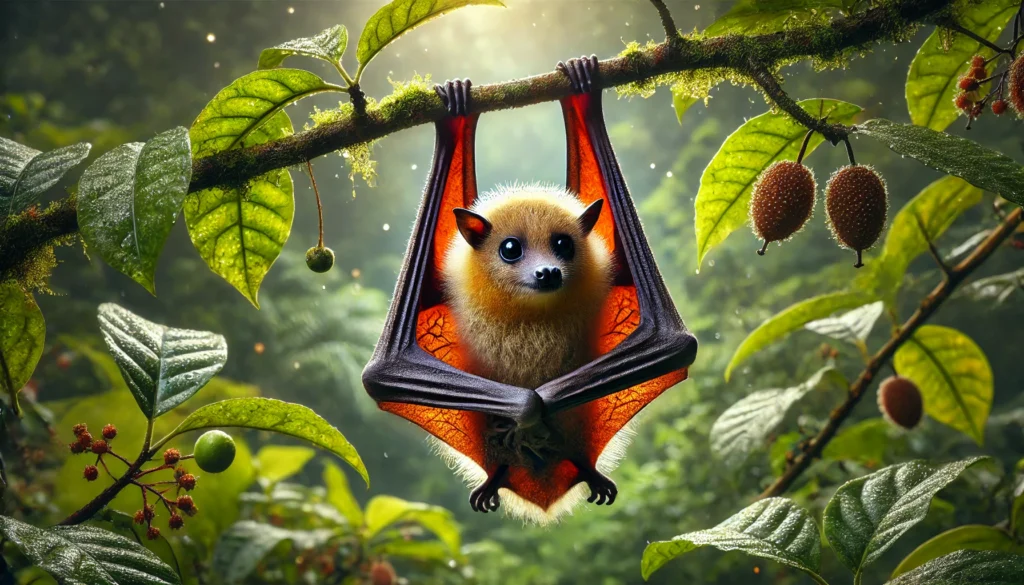Picture this: you’re strolling through a lush Philippine forest at night, enjoying the symphony of crickets and the gentle rustling of leaves. Suddenly, a dark shape swoops overhead, barely visible against the starry sky. No, it’s not a tiny, furry superhero (though that would be pretty cool). It’s the Philippine Naked-Backed Fruit Bat, the unsung hero of the forest! This fascinating creature might not have a cape or superpowers, but it plays a crucial role in maintaining the health and biodiversity of Philippine ecosystems. So, buckle up, bat enthusiasts and curious readers alike, as we embark on a journey to explore the world of these incredible flying mammals. From their quirky appearance to their vital ecological contributions, we’ll discover why these bats deserve our attention, admiration, and protection. Get ready to have your preconceptions about bats turned upside down (pun intended) as we delve into the captivating life of the Philippine Naked-Backed Fruit Bat!
The Naked Truth: Appearance and Characteristics
A Face Only a Mother Could Love?
Let’s address the elephant (or should I say, bat) in the room: the Philippine Naked-Backed Fruit Bat isn’t going to win any beauty pageants anytime soon. With its wrinkled face, beady eyes, and, well, naked back, this bat looks like it’s perpetually having a bad hair day. But hey, who are we to judge? Beauty is in the eye of the beholder, and these quirky features serve important purposes in the bat’s daily life.
Size Matters (Or Does It?)
When it comes to size, the Philippine Naked-Backed Fruit Bat is no heavyweight champion. These little guys typically measure between 11.5 to 14 centimeters in length and weigh a mere 70 to 85 grams. To put that into perspective, imagine holding a small banana in your hand – that’s about the size of our batty friend. But don’t let their diminutive stature fool you; these bats pack a powerful punch when it comes to their ecological impact.
The Naked Truth
Now, let’s talk about the elephant in the room – or rather, the lack of fur on the bat’s back. The Philippine Naked-Backed Fruit Bat got its name for a reason: a significant portion of its back is indeed naked. This unique feature isn’t just a fashion statement; it serves a practical purpose. The bare skin on their back allows them to regulate their body temperature more efficiently, which is particularly useful when they’re roosting in warm caves or flying around on balmy Philippine nights.
Wings of Wonder
Like all bats, the Philippine Naked-Backed Fruit Bat sports impressive wings. These aren’t your run-of-the-mill bird wings, though. Bat wings are actually modified hands, with a thin membrane of skin stretched between elongated finger bones. This unique structure allows for incredible maneuverability in flight, making these bats the acrobats of the night sky. So, the next time you see one zipping through the air, remember: you’re witnessing an evolutionary marvel in action!
Home Sweet Home: Habitat and Distribution
Island Paradise
The Philippine Naked-Backed Fruit Bat is, as its name suggests, endemic to the Philippines. But don’t expect to find these critters sunbathing on the beaches of Boracay or sipping coconut water in Palawan (though that would be a sight to behold). These bats prefer the lush, tropical forests that dot the Philippine archipelago. They’re particularly fond of lowland and montane forests, where they can find plenty of trees for roosting and fruiting plants for snacking.
The Real Estate Market for Bats
When it comes to choosing a home, these bats aren’t too picky. They’ve been known to roost in a variety of locations, including caves, rock crevices, and even the hollows of large trees. Talk about flexible living arrangements! However, like many of us, they do have their preferences. Large colonies of Philippine Naked-Backed Fruit Bats often favor spacious caves, where they can hang out (literally) with hundreds or even thousands of their closest friends.
A Shrinking World
Unfortunately, the Philippine Naked-Backed Fruit Bat’s habitat is under threat. Deforestation, land conversion for agriculture, and urban development are all taking their toll on the forests these bats call home. It’s like someone’s playing a cruel game of musical chairs with their habitat, and every time the music stops, there are fewer places for them to live. This habitat loss is one of the primary reasons why conservation efforts for these bats are so crucial.
Nightlife Connoisseurs: Behavior and Social Structure
Night Owls (Or Should We Say Night Bats?)
As you might have guessed, the Philippine Naked-Backed Fruit Bat is nocturnal. When the sun goes down and the rest of the world is winding down, these little guys are just getting started. They emerge from their roosts at dusk, ready to paint the town red (or at least, ready to find some ripe fruit to munch on). Their nocturnal lifestyle is more than just a preference for late-night snacking; it’s an evolutionary adaptation that helps them avoid predators and reduces competition with daytime foragers.
Social Butterflies
Despite their somewhat grumpy appearance, Philippine Naked-Backed Fruit Bats are surprisingly social creatures. They often roost in large colonies, sometimes numbering in the thousands. These bat parties aren’t just for fun (though I’m sure they have a blast); roosting in groups provides safety in numbers and helps with thermoregulation. It’s like a constant slumber party, only with more hanging upside down and less pillow fighting.
The Dating Game
When it comes to romance, these bats keep things interesting. They’re polygynandrous, which means that both males and females have multiple mating partners. It’s like a fruit bat version of speed dating, only with more echolocation and less awkward small talk. Mating typically occurs once a year, with females giving birth to a single pup after a gestation period of about 3-5 months. Talk about a long pregnancy for such a small creature!
Fruit Fanatics: Diet and Feeding Habits
Fruity Favorites
As their name suggests, Philippine Naked-Backed Fruit Bats are big fans of fruit. They’re like the fruit salad enthusiasts of the bat world, with a particular fondness for figs, mangoes, and other soft, juicy fruits. But don’t be fooled – these bats aren’t mindless munchers. They play a crucial role in seed dispersal, helping to maintain the diversity and health of Philippine forests.
Table: Favorite Fruits of the Philippine Naked-Backed Fruit Bat
| Fruit | Scientific Name | Why Bats Love It |
|---|---|---|
| Fig | Ficus spp. | Soft, easy to eat, high in energy |
| Mango | Mangifera indica | Sweet, nutritious, abundant in season |
| Banana | Musa spp. | Soft texture, high in potassium |
| Papaya | Carica papaya | Easily digestible, rich in vitamins |
| Guava | Psidium guajava | Aromatic, good source of vitamin C |
Nectar Nibbling
While fruits are their main course, these bats aren’t above indulging in a little nectar now and then. They visit flowering plants to sip on sweet nectar, inadvertently picking up pollen on their fur in the process. It’s like they’re running a mobile pollination service without even realizing it!
The Art of Eating
Watching a Philippine Naked-Backed Fruit Bat eat is quite a spectacle. They use their sharp teeth to bite into fruits, then mash the pulp against the roof of their mouth with their tongue. The juices are swallowed, while the seeds and pulp are spat out. It’s not the most elegant dining process, but it gets the job done and helps spread seeds far and wide.
Nature’s Gardeners: Ecological Importance
Seed Dispersal Dynamos
Remember those seeds the bats spit out after enjoying a fruity feast? Well, those seeds don’t just disappear into thin air. As the bats fly from tree to tree, they’re essentially planting new trees with every pit stop. It’s like they’re running a reforestation project without even knowing it! This seed dispersal is crucial for maintaining the genetic diversity and health of Philippine forests.
Pollination Pros
But wait, there’s more! When these bats visit flowers for a nectar snack, they’re not just satisfying their sweet tooth. As they flit from flower to flower, they’re transferring pollen, helping plants reproduce. Many plants have evolved to be particularly attractive to bats, with night-blooming flowers that produce strong scents to lure in these nocturnal pollinators.
Forest Doctors
By dispersing seeds and pollinating plants, Philippine Naked-Backed Fruit Bats play a crucial role in forest regeneration and maintenance. They’re like the unsung heroes of the ecosystem, working tirelessly through the night to keep the forests healthy and diverse. Without these bats, many plant species would struggle to reproduce and spread, potentially leading to a cascade of ecological changes.
Table: Ecological Services Provided by Philippine Naked-Backed Fruit Bats
| Service | Description | Impact |
|---|---|---|
| Seed Dispersal | Spread seeds through defecation and spitting | Aids in forest regeneration and plant distribution |
| Pollination | Transfer pollen between flowers while feeding on nectar | Facilitates plant reproduction, especially for night-blooming species |
| Pest Control | Indirectly control insect populations by maintaining plant diversity | Helps maintain ecological balance |
| Nutrient Cycling | Contribute to nutrient cycling through droppings | Enhances soil fertility in forests |
Threats and Conservation: Battling for Survival
The Deforestation Dilemma
One of the biggest threats facing the Philippine Naked-Backed Fruit Bat is habitat loss due to deforestation. As forests are cleared for agriculture, urban development, and logging, these bats are losing their homes faster than you can say “holy guano, Batman!” It’s like someone’s playing a cruel game of musical chairs with their habitat, and every time the music stops, there are fewer places for them to live.
The Misunderstood Mammal
Despite their important ecological role, bats often get a bad rap. Misconceptions and fears about bats carrying diseases have led to persecution in some areas. It’s like these poor creatures are the victims of a smear campaign, and they don’t even have a PR team to defend them! Education and awareness programs are crucial to help people understand the true nature and importance of these fascinating animals.
Hunting: Not Just a Game
In some parts of the Philippines, bats are hunted for food or traditional medicine. While this practice has cultural roots, it’s putting additional pressure on already vulnerable bat populations. It’s a complex issue that requires balancing conservation needs with cultural practices and local livelihoods.
Conservation Efforts: A Ray of Hope
The good news is that efforts are underway to protect the Philippine Naked-Backed Fruit Bat and its habitat. Conservation organizations are working to establish protected areas, promote sustainable forest management, and educate communities about the importance of bats. It’s like a superhero team-up, but instead of capes and tights, these heroes wear khakis and carry binoculars.
Fascinating Facts: Did You Know?
Echolocation Experts
Like many bats, the Philippine Naked-Backed Fruit Bat uses echolocation to navigate in the dark. They emit high-pitched sounds and listen to the echoes to build a ‘sound picture’ of their environment. It’s like they have built-in sonar, making them the submarines of the sky!
Upside-Down Sleepers
These bats sleep hanging upside down, which might seem odd to us, but it’s perfectly normal for them. This position allows them to take flight quickly if needed – they just let go and they’re airborne! Talk about an efficient morning routine.
Long-lived Littles
Despite their small size, Philippine Naked-Backed Fruit Bats can live relatively long lives. In captivity, some individuals have been known to live up to 20 years. That’s a lot of fruit eating and seed spreading in one lifetime!
Silent Flyers
Unlike the noisy flapping of bird wings, bat flight is nearly silent. This stealthy movement helps them sneak up on fruit without alerting potential predators. It’s like they’re the ninjas of the night sky!
Why We Should Care
As we wrap up our journey into the world of the Philippine Naked-Backed Fruit Bat, it’s clear that these little creatures are far more than just quirky-looking flying mammals. They’re essential components of Philippine ecosystems, playing crucial roles in seed dispersal and pollination. Their presence (or absence) can be an indicator of forest health, making them important not just for their own sake, but for the entire ecosystem they inhabit.
Conservation efforts for these bats aren’t just about protecting a single species; they’re about preserving the intricate web of life in Philippine forests. By safeguarding the habitats of these bats, we’re also protecting countless other species and maintaining the ecological balance that keeps these ecosystems healthy and resilient.
So, the next time you hear a rustling in the trees at night or spot a dark shape flitting across the moon, take a moment to appreciate the Philippine Naked-Backed Fruit Bat. They may not be the cutest or most glamorous creatures in the forest, but they’re working tirelessly through the night to keep the ecosystem running smoothly. And that, my friends, is true beauty – naked back and all!
Disclaimer: This article is based on scientific information available up to 2020. While we strive for accuracy, new research may have emerged since then. If you notice any inaccuracies or have updated information, please report them so we can correct them promptly. Remember, in the world of science, knowledge is always evolving – just like our batty friends!




